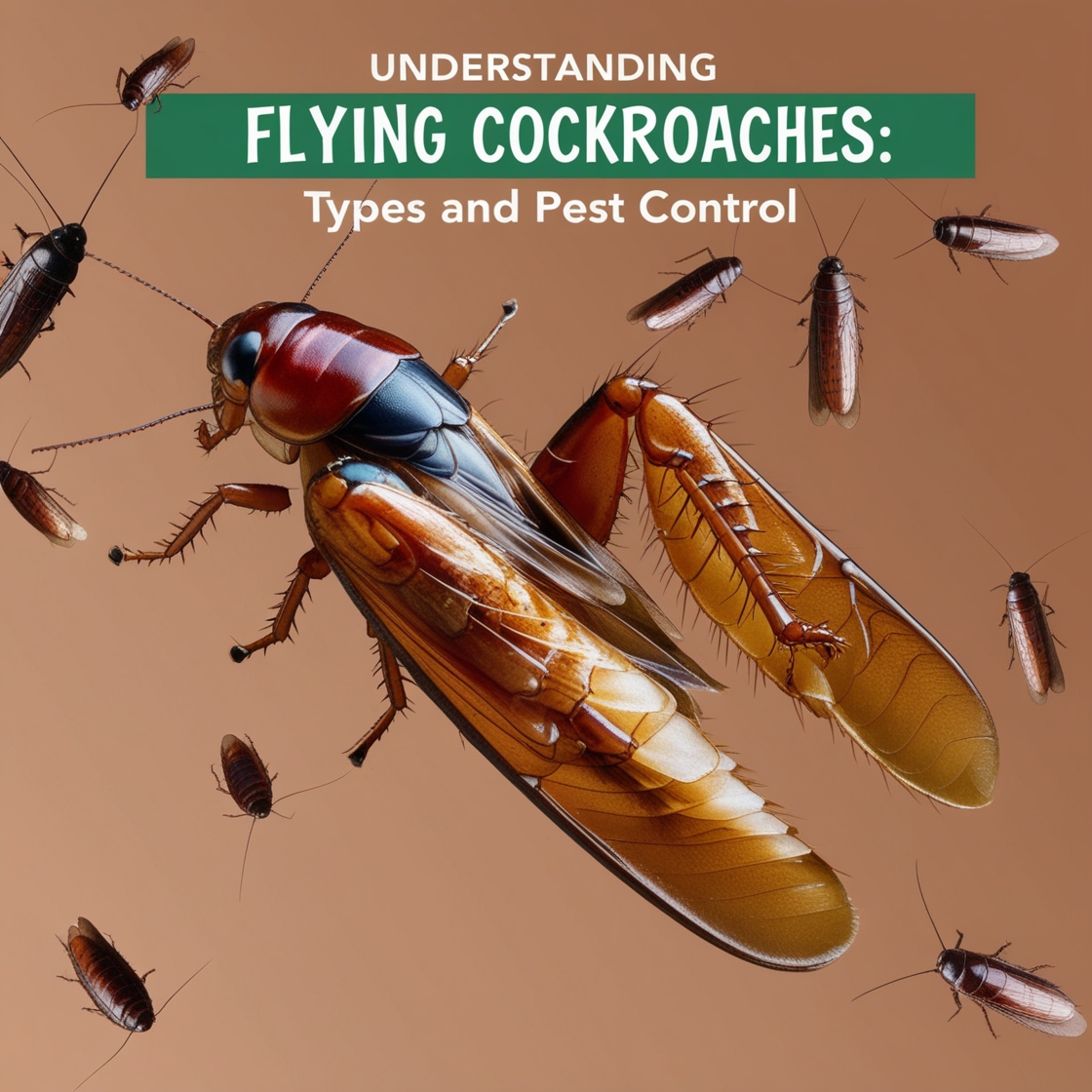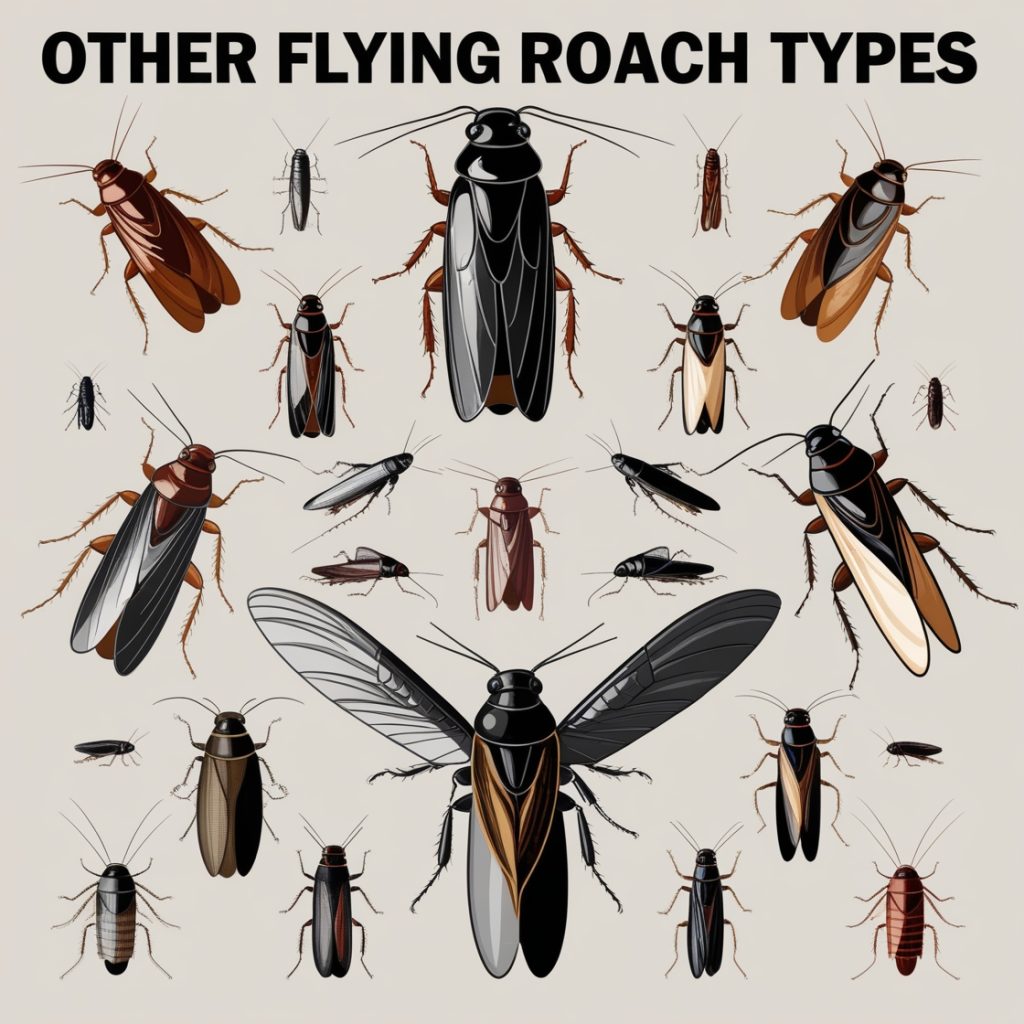Understanding Flying Cockroaches: Types and Pest control

Explore the world of flying cockroaches and their species. Learn how to identify them, their attraction to homes, and effective pest control solutions!
Introduction to Flying Cockroaches
When most people think of cockroaches, they envision skittering insects that quickly vanish into dark crevices. However, many are surprised to learn that some cockroaches can fly. This ability adds another dimension to the challenge of dealing with these persistent pests. Flying cockroaches are not just a nuisance; they represent a significant concern for homeowners and businesses alike.
Cockroaches have been around for millions of years, evolving to become one of the most adaptable and resilient pests known to humankind. With over 4,000 species worldwide, about 55 types of cockroaches are found in the United States alone. Among these, several species are capable of flight, adding to their ability to infest and spread quickly.
What Makes a Cockroach Fly?
Cockroaches have wings, but not all species use them for flight. The ability to fly varies among cockroach species, with some being more adept flyers than others. Flying cockroaches use their wings to glide short distances or to escape potential threats. However, it’s important to note that cockroaches do not fly in the same way as birds or other insects. Instead, they often use their wings to aid in gliding from higher to lower surfaces.
Most cockroaches that can fly are not particularly strong or graceful fliers. They typically flap their wings to fly short distances, often in a somewhat erratic manner. This limited flight capability is still enough to allow them to escape predators, find mates, or locate new food sources more efficiently than their non-flying counterparts.
Why Do Cockroaches Have Wings?
Even cockroaches that cannot fly often have wings. These wings serve multiple purposes, including temperature regulation and mating displays. For species capable of flight, wings provide an additional means of locomotion and escape.
Interestingly, not all cockroaches with wings can fly. Some species, like the German cockroach, have wings but rarely use them for flight. Others, like the Oriental cockroach, have wings but are incapable of flight altogether. This variation in wing functionality across different cockroach species highlights the diversity within this group of insects.
Common Flying Cockroach Species
Several species of cockroaches can fly or glide. Understanding the different types of flying cockroaches is crucial for effective pest control. Let’s explore some of the most common flying cockroach species found in homes and businesses.
American Cockroach: The Infamous Palmetto Bug
The American cockroach, also known as the palmetto bug, is one of the most common flying cockroach species. These large, reddish-brown insects are capable of short flights and are often found in homes and businesses, especially in warmer climates like Florida.
American cockroaches are among the largest cockroach species found in the United States, growing up to 1.5 inches in length. They are known for their reddish-brown color and the distinctive figure-eight pattern on the back of their heads. While they prefer warm and humid environments, they can adapt to various conditions, making them a common pest in many parts of the country.
These cockroaches are capable of flight, but they more commonly use their wings to glide from higher to lower surfaces. They are attracted to light and may fly towards light sources, which often leads them into homes and buildings.
Smoky brown Cockroach: A Frequent Flyer
The smoky brown cockroach, sometimes referred to as the smoky brown cockroach, is another species known for its flying ability. These pests are attracted to light and often enter homes through small openings. Smokybrown cockroaches are dark brown to mahogany in color and can grow up to 1.5 inches in length.
Unlike some other cockroach species, smokybrown cockroaches are relatively strong fliers. They are more likely to use their wings for sustained flight, making them particularly problematic for homeowners. These cockroaches prefer outdoor environments with high humidity but will often seek shelter indoors during dry or cold weather.
Other Flying Roach Types

Several other cockroach species can fly or glide, including:
- Asian cockroaches: These cockroaches are strong fliers and are often mistaken for moths due to their attraction to light.
- Australian cockroaches: Similar in appearance to American cockroaches but slightly smaller, these pests are capable of flight and are often found in greenhouses and other warm, humid environments.
- Cuban cockroaches: Also known as the green cockroach, these insects are excellent fliers and are attracted to lights.
- Wood cockroaches: Several species of wood cockroaches, including the Pennsylvania wood cockroach and Florida woods cockroaches, are capable of flight. These cockroaches are typically found outdoors but may occasionally enter homes.
- German cockroach: While not known for their flying abilities, German cockroaches do have wings and can glide short distances. They are one of the most common household pests and can quickly infest homes and businesses.
Understanding the specific type of flying cockroach you’re dealing with is crucial for effective pest control. Different species may require different treatment approaches, and knowing their habits and preferences can help in developing a targeted control strategy.
Flying Cockroach Behavior
To effectively control flying cockroaches, it’s essential to understand their behavior. This knowledge can help in predicting their movements and developing strategies to prevent and eliminate infestations.
When and Why Cockroaches Fly
Cockroaches typically use their wings to fly short distances or to escape danger. They may also fly when seeking mates or new food sources. Many species are attracted to light, which can draw them into homes and businesses.
Several factors can trigger flying behavior in cockroaches:
- Temperature: Warmer temperatures often increase cockroach activity, including flying.
- Mating: Male cockroaches may fly to locate females during mating season.
- Food search: When food sources become scarce, cockroaches may fly to find new feeding areas.
- Escaping threats: Cockroaches use their wings to quickly escape from predators or other perceived dangers.
- Seasonal changes: Some species, like wood cockroaches, may fly more frequently during certain times of the year, often coinciding with mating seasons.
Understanding these triggers can help in predicting when flying cockroach activity might increase and allow for more targeted pest control efforts.
The Difference Between Flying and Gliding
Not all cockroaches that appear to be flying are actually doing so. Many species use their wings to glide from higher to lower surfaces, which can be mistaken for true flight. This behavior allows them to quickly escape threats or move to new locations.
True flying involves powered, sustained flight, where the insect uses its wings to generate lift and propulsion. Gliding, on the other hand, involves using the wings to control descent from a higher point to a lower one, often covering a significant horizontal distance in the process.
Many cockroach species, including the American cockroach, are more adept at gliding than true flying. They often climb to a high point, spread their wings, and glide to a lower surface. This behavior can still allow them to cover significant distances and can be just as problematic as true flight in terms of pest control.
Dealing with Flying Cockroach Infestations
A flying cockroach infestation can be particularly distressing for homeowners and businesses. These pests can spread quickly and are often more visible than their non-flying counterparts, leading to increased anxiety and discomfort for occupants.
Signs of a Flying Roach Infestation
Recognizing the signs of a flying cockroach infestation early can help in addressing the problem before it becomes severe. Common signs of a cockroach infestation include:
- Sightings of live or dead cockroaches: This is often the most obvious sign. If you see cockroaches during the day, it could indicate a severe infestation, as these typically nocturnal pests are being forced out of hiding due to overcrowding.
- Cockroach droppings: Cockroach feces resemble small, dark pellets or coffee grounds. In cases of flying cockroaches, you might find these droppings in unusual places, such as on top of cabinets or shelves.
- Egg cases: Female cockroaches produce egg cases called oothecae. These can often be found in hidden areas or stuck to surfaces.
- A musty odor: Large cockroach infestations often produce a distinct, unpleasant smell.
- Damage to food packaging or books: Cockroaches may chew through packaging or paper products, leaving behind irregular damage.
- Smear marks: In areas with high humidity, cockroaches may leave behind dark, irregular smear marks where they travel frequently.
When dealing with flying cockroaches specifically, you may also notice:
- Cockroaches around light sources: Flying cockroaches are often attracted to light, so you might see them congregating near windows, outdoor lights, or other bright areas.
- Wings or wing parts: You might find discarded wings or wing parts, especially after molting.
- Increased nighttime activity: While all cockroaches are generally more active at night, flying species may be more noticeable as they move towards light sources.
Preventing Flying Cockroach Problems
Preventing cockroaches from entering your home is key to avoiding infestations. Some preventive measures include:
- Sealing entry points: Carefully inspect your home’s exterior and seal any cracks, gaps, or holes that could serve as entry points. Pay special attention to areas around pipes, windows, and doors.
- Proper food storage: Keep food in airtight containers and clean up spills promptly. Don’t leave pet food out overnight.
- Regular cleaning and decluttering: Maintain a clean home, paying special attention to kitchens and bathrooms. Reduce clutter, which can provide hiding spots for cockroaches.
- Moisture control: Fix leaky pipes and faucets, and use dehumidifiers in damp areas. Cockroaches are attracted to moisture, so keeping your home dry can help deter them.
- Proper waste management: Use sealed trash cans and dispose of garbage regularly. Keep outdoor trash areas clean and away from the house.
- Inspect incoming items: Carefully check boxes, grocery bags, and secondhand items for signs of cockroaches before bringing them into your home.
- Use proper outdoor lighting: Choose yellow or sodium vapor lights for outdoor areas, as these are less attractive to insects than white lights.
- Maintain your yard: Keep your yard free of debris and woodpiles, which can harbor cockroaches. Trim bushes and trees away from the house to reduce access points.
- Use natural repellents: Some plants like bay leaves, cucumber, and garlic are thought to repel cockroaches. While not a standalone solution, they can be part of an integrated pest management approach.
- Regular inspections: Conduct regular inspections of your home, especially in dark, warm, and humid areas where cockroaches prefer to hide.
How to Get Rid of Flying Cockroaches
If you’re facing a flying cockroach infestation, there are several steps you can take to eliminate these pests. The approach you choose may depend on the severity of the infestation and your personal preferences regarding pest control methods.
DIY Methods for Eliminating Flying Roaches
For minor infestations, you might try these DIY methods:
- Use cockroach baits and traps: These can be effective in controlling cockroach populations. Place them in areas where you’ve seen cockroach activity.
- Apply diatomaceous earth: This natural substance can be sprinkled in areas where cockroaches travel. It damages their exoskeletons, leading to dehydration.
- Use boric acid: This is a natural pesticide that can be effective against cockroaches. Apply it in thin layers in areas where cockroaches are likely to walk through it.
- Essential oils: Some essential oils, like peppermint and tea tree oil, are thought to repel cockroaches. While not a standalone solution, they can be used as part of an integrated approach.
- Sticky traps: These can catch flying cockroaches and help you identify problem areas.
- Keep your home clean and dry: Regular cleaning, especially in kitchens and bathrooms, can significantly reduce cockroach populations.
- Seal off entry points: Use caulk or other appropriate materials to seal cracks and crevices where cockroaches might enter.
- Use a mixture of sugar and baking soda: The sugar attracts the cockroaches, while the baking soda is harmful to them when ingested.
- Citrus peels or cucumber slices: These are natural repellents that can be placed in areas where cockroaches are commonly seen.
- Maintain a clutter-free environment: Reduce potential hiding spots by keeping your home organized and clutter-free.
When to Call a Pest Control Professional
For severe infestations or persistent problems, it’s often best to call a professional pest control service. Pest control experts can:
- Identify the type of cockroach infesting your home: Different species may require different treatment approaches.
- Develop a targeted treatment plan: Based on the specific type of cockroach and the extent of the infestation.
- Use professional-grade pesticides: These are often more effective than DIY solutions and can be applied safely by trained professionals.
- Provide ongoing prevention strategies: To help prevent future infestations.
- Conduct thorough inspections: To identify all potential problem areas and hiding spots.
- Offer integrated pest management solutions: Combining various control methods for more effective and long-lasting results.
- Address hard-to-reach areas: Professionals have the tools and expertise to treat areas that might be difficult for homeowners to access.
- Provide follow-up treatments: To ensure the infestation is fully eliminated.
Professional pest control services are particularly useful when dealing with flying cockroach species, as these pests can be more challenging to eliminate due to their mobility. If you’ve tried DIY methods without success, or if you’re dealing with a large-scale infestation, it’s time to consider professional help.
The Impact of Flying Cockroaches
Flying cockroaches can have significant impacts on both health and property. Understanding these impacts can help motivate effective control measures and highlight the importance of prompt action when dealing with an infestation.
Health Risks and Property Damage
Cockroaches are known to carry various pathogens and can trigger allergies and asthma in some individuals. Their presence can also lead to property damage, as they may infest and contaminate food supplies or damage books and other paper products.
Health risks associated with cockroaches include:
- Allergies and asthma: Cockroach allergens can trigger allergic reactions and asthma attacks, especially in children.
- Food contamination: Cockroaches can spread bacteria like Salmonella and E. coli, potentially contaminating food and cooking surfaces.
- Spread of pathogens: Cockroaches can carry and spread various disease-causing organisms.
- Skin irritations: In some cases, cockroach bites or contact with cockroach droppings can cause skin irritations or rashes.
Property damage caused by cockroaches may include:
- Food spoilage: Cockroaches can infest and contaminate food supplies, leading to waste and potential health risks.
- Damage to paper products: Cockroaches may feed on books, wallpaper, or other paper-based items.
- Electrical damage: In some cases, cockroaches can short out electrical systems by crawling inside appliances or chewing on wires.
- Stains and odors: Cockroach droppings and secretions can leave stains and unpleasant odors on surfaces.
- Damage to fabrics: Cockroaches may chew on or stain clothing, curtains, or other fabrics.
Psychological Effects of Flying Cockroach Encounters
The sight of a flying cockroach can be particularly distressing for many people. The unpredictable nature of their flight patterns can cause fear and anxiety, making flying cockroach infestations especially problematic in homes and businesses.
Psychological impacts may include:
- Stress and anxiety: The fear of encountering flying cockroaches can cause significant stress, especially for individuals with insect phobias.
- Sleep disturbances: Worry about cockroach activity can lead to difficulty sleeping or nightmares.
- Embarrassment: People may feel ashamed or embarrassed about having a cockroach infestation, leading to social withdrawal.
- Decreased quality of life: Constant worry about cockroaches can negatively impact overall well-being and enjoyment of one’s living space.
- Obsessive behaviors: Some individuals may develop obsessive cleaning or checking behaviors in response to cockroach fears.
Understanding these psychological impacts underscores the importance of effective cockroach control, not just for physical health and property protection, but also for mental well-being.
Conclusion: Mastering Flying Cockroach Control
Understanding flying cockroaches is crucial for effective pest control. While these insects can be challenging to manage, a combination of prevention, DIY methods, and professional pest control services can help keep your home or business free from these unwanted visitors.
Remember that different cockroach species may require different control methods. Identifying the specific type of flying cockroach you’re dealing with can help you choose the most effective treatment strategy. Whether you’re facing American cockroaches, smokybrown cockroaches, or other flying roach species, persistence and a multi-faceted approach are key to successful pest control.
By staying informed about cockroach behavior, implementing preventive measures, and knowing when to seek professional help, you can effectively manage flying cockroach problems and maintain a pest-free environment. With the right knowledge and tools, you can overcome the challenge of flying cockroaches and enjoy a cleaner, healthier living space.
